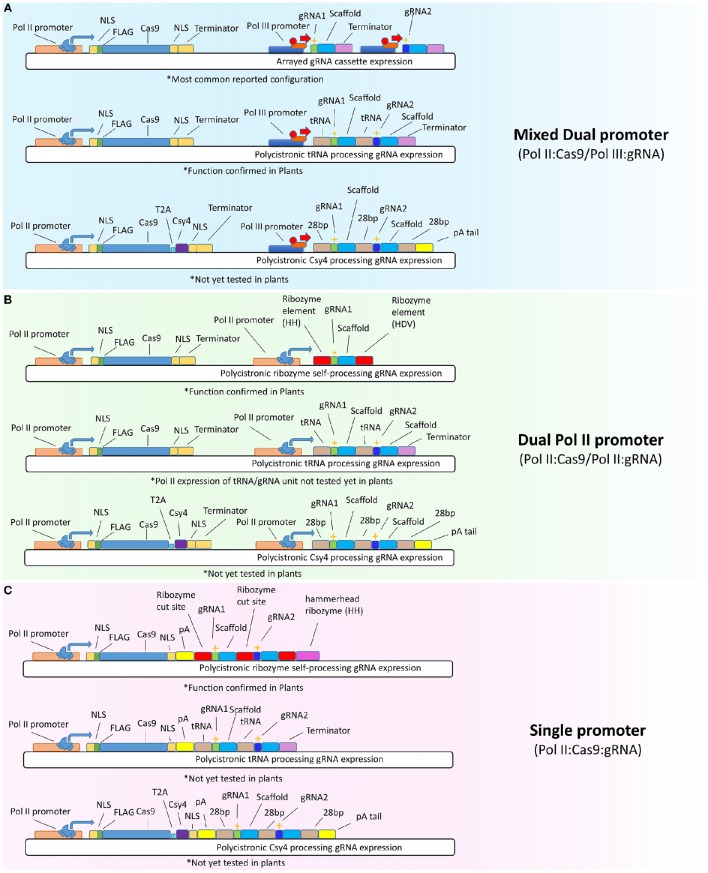Figure 1.
Diversified plant CRISPR-Cas9 expression systems. (A) The most common expression system is the mixed dual promoter system (Pol II:Cas9/Pol III:gRNA) where Cas9 is expressed from RNA polymerase II (Pol II) based promoters and gRNAs are expressed from RNA polymerase III promoters (Pol III promoters—such as U6 and U3). Top vector shows the canonical arrayed gRNA cassette expression system which expresses each gRNA with its own Pol III promoter, gRNA spacer, scaffold, and terminator sequences. Cas9 is expressed from a Pol II promoter and typically has N and C terminal nuclear localization signals (NLS), a FLAG tag for immunodetection, and a 3′ transcriptional terminator sequence. Middle vector shows the polycistronic tRNA processing gRNA expression system which expresses Cas9 using Pol II and gRNAs from a polycistronic Pol III driven transcript. tRNA encoding sequences act to process out RNA sequences they flank using endogenous tRNA processing ribonucleases. Bottom vector is the polycistronic Csy4 processing gRNA expression system that has been tested to function in mammalian cells, but not yet in plants. The Csy4 system utilizes the CRISPR type III ribonuclease, Csy4, to cleave the (28 bp) sequence which cuts out RNA sequences flanked by these sequence elements. A poly A tail (pA tail) is used to stabilize the 3′ RNA transcript sequence after processing. (B) The Dual (Pol II) promoter system (Pol II:Cas9/Pol II:gRNA) uses RNA polymerase II promoters to drive both Cas9 and gRNA expression. Different Pol II promoters can be used simultaneously to express the separate Cas9 or gRNA transcripts providing great flexibility and capacity for constitutive or inducible RNA expression. Top vector shows the polycistronic ribozyme self-processing gRNA expression system which processes out gRNAs from Pol II primary transcripts using the hammerhead (HH) and (HDV) ribozyme cleavage sequence elements. Middle shows the polycistronic tRNA processing gRNA expression system from (A) but adapted for the dual promoter system by Pol II promoter controlled transcription. Bottom shows the Csy4 processing gRNA expression system as above but under the control of two separate Pol II promoters. Note that Csy4 ribonuclease must be expressed from the Cas9 transcript using the translational viral cleavage sequence (T2A) which allows for two functional polypeptides to be produced from a single transcript. (C) Shows the polycistronic ribozyme self-processing system, the tRNA processing and Csy4 processing gRNA expression systems under the the control of a single Pol II promoter. Note that the single promoter system is the most compact of all the systems. *Experimentally validated function in plants is denoted below vector.

